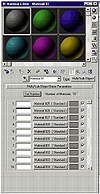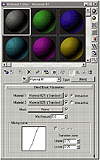| ISO 9000 | ISO 14000 |
 GMP Consulting |
For each sub-material, you will see a number followed by an open space. That number is the Material ID number that each sub-material is assigned. These numbers match up to the numbers that are assigned to the certain faces of an object. The open area is used for naming the sub-materials. When you use Multi/Sub-Object materials, it is a good idea to name your sub-materials and also practice using the Material/Map Navigator. This is where it really comes in handy.
Hopefully, nothing there is new to you. Use the Go to Parent and Go to Sibling buttons to scroll through the Multi/Sub-Object material. As you do this, keep the Navigator open because it follows the Editor to the different levels.
Make sure you are back to the top level of the material. Click the color swatch below the yellow one. Change the color to a green and change the name appropriately. Make similar changes for the last two sub-materials. You should now have a material that looks similar to the one below (Figure 8.20) ready to be applied to an object in your scene.
Just remember when you use the Multi/Sub-Object to take your time with it. Be sure to name all the sub-materials and use the Navigator. Pay attention to where you are in the Material Editor and at what level. This material type is really just a series of Standard materials (though you can build it from more complicated types if you need to). If you feel comfortable with using and dealing with Standard materials, then you will not have any problems at all with Multi/Sub-Object materials. The Blend Type The last type of material we will look at is the Blend material, which is made by mixing two materials into one. The Blend material parameters (shown in Figure 8.21) include a Mix Map for more control over how the two materials are blended together. Table 8.7 goes over some of the main features of the Blend material.
Let’s create a quick and easy Blend material.
The sphere object should be Green. The reason it’s green is because a Mix Amount has not been set; when the Mix Amount is set at 0, the material in slot number 1 controls the look. What do you think would happen if you put a value of 100 in the Mix Amount? Of course: the material will be completely red. (Try it.) When the Mix Amount is set to 100, Material 2 will be rendered. So the percentage in the Mix Amount is “percent of the Blend that looks like Material 2.” We mentioned earlier not to trust the viewport. Always render your scene to see how materials ultimately look. If you set the Mix Amount to 100 but didn’t re-render, you now have red sample sphere in the Material Editor but the object in the viewport is still green.
Take some time to try some different settings in the Mix Amount area. Before we talk about maps, it might be a good for you to review what we have learned so far. We’ve discussed a lot of options, but it is important that you understand the basics of the Material Editor and materials in general before you move on to maps.
© 2000, Frol (selection, edition, publication) |
||||||||||||||||||||||||||||||||
|
|



